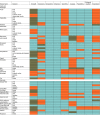Evaluation of the Quality of Evidence of the Association of Foods and Nutrients With Cardiovascular Disease and Diabetes: A Systematic Review
- PMID: 35113165
- PMCID: PMC8814912
- DOI: 10.1001/jamanetworkopen.2021.46705
Evaluation of the Quality of Evidence of the Association of Foods and Nutrients With Cardiovascular Disease and Diabetes: A Systematic Review
Abstract
Importance: Poor diet is a leading global factor associated with cardiometabolic disease (CMD). Understanding the quality of evidence of the associations between specific dietary factors and CMD, including effect size (relative risk [RR]) and uncertainty, is essential to guide policy and consumer actions to achieve healthy diet and public health goals.
Objective: To assess the quality of evidence of the associations between specific dietary factors and CMD as well as the quantitative evidence for RRs and the uncertainty of these risk estimates.
Evidence review: PubMed and the reference lists of eligible articles were searched between May 1, 2015, and February 26, 2021, for systematic reviews with meta-analyses of randomized clinical trials and prospective cohort studies that analyzed the consumption of 1 or more of the dietary factors of interest; reported dose-response meta-analyses; included healthy adults; and assessed 1 or more of the outcomes of interest. Study characteristics and RR estimates were extracted in duplicate. For identified associations, quality of evidence was assessed using the Bradford-Hill criteria for causation.
Findings: A total of 2058 potentially relevant reports were identified, from which 285 full-text articles were assessed for eligibility. The final selection of articles included 28 meta-analyses representing 62 associations between diet and CMD. Among these associations, 10 foods, 3 beverages, and 12 nutrients had at least probable evidence of associations with coronary heart disease, stroke, and/or diabetes. Most RRs ranged from 0.87 to 0.96 per daily serving change for protective associations and from 1.06 to 1.15 per daily serving change for harmful associations. Most identified associations were protective (n = 38) and a smaller number were harmful (n = 24), with a higher risk associated with higher intake.
Conclusions and relevance: This systematic review summarized the current quality of evidence of the associations of specific dietary factors with coronary heart disease, stroke, and diabetes. These findings may inform dietary guidance, the assessment of disease burden in specific populations, policy setting, and future research.
Conflict of interest statement
Figures




References
-
- Roth GA, Mensah GA, Johnson CO, et al. ; GBD-NHLBI-JACC Global Burden of Cardiovascular Diseases Writing Group . Global burden of cardiovascular diseases and risk factors, 1990-2019: update from the GBD 2019 Study. J Am Coll Cardiol. 2020;76(25):2982-3021. doi:10.1016/j.jacc.2020.11.010 - DOI - PMC - PubMed
-
- Saeedi P, Petersohn I, Salpea P, et al. ; IDF Diabetes Atlas Committee . Global and regional diabetes prevalence estimates for 2019 and projections for 2030 and 2045: results from the International Diabetes Federation Diabetes Atlas, 9th edition. Diabetes Res Clin Pract. 2019;157:107843. doi:10.1016/j.diabres.2019.107843 - DOI - PubMed
Publication types
MeSH terms
LinkOut - more resources
Full Text Sources
Medical

